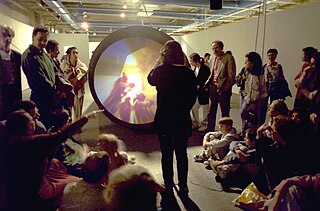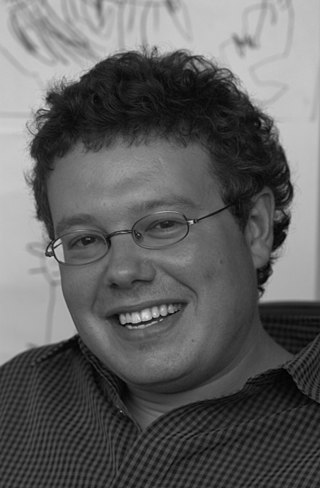This article needs additional citations for verification .(December 2023) |
Blast Theory is an artists' group that specializes in work that mixes interactive media, digital broadcasting and live performance.
This article needs additional citations for verification .(December 2023) |
Blast Theory is an artists' group that specializes in work that mixes interactive media, digital broadcasting and live performance.
The group was founded in 1991 by Matt Adams, Niki Jewett, Will Kittow and Ju Row Farr. The group is currently led by Matt Adams and Nick Tandavanitj. Ju Row Farr left her leadership role in 2023. [1] Other members include the film maker John Hardwick and the late performer Jamie Iddon. [2] Over its history, Blast Theory's work has explored interactivity and the social and political aspects of technology through a multitude of forms – using performance, installation, video, mobile and online technologies.
Currently based at their studios in Portslade, Blast Theory shows work nationally and internationally, working with a number of Associate Artists on different projects. The group has collaborated with The University of Nottingham's Mixed Reality Lab since 1998. [3] Works created collaboratively with the MRL include Desert Rain (1999), Can You See Me Now? (2001) and Rider Spoke (2007). Blast Theory's work has been shown at NTT InterCommunication Center (ICC) in Tokyo, the Chicago Museum of Contemporary Art, Sydney Biennale, National Museum in Taiwan, Hebbel Theater in Berlin, Basel Art Fair, Dutch Electronic Arts Festival, Sónar Festival in Barcelona, and Palestine International Video Festival. [4] [5] [6] [7] Commissions include You Get Me (2008) at the Royal Opera House, Covent Garden; Ulrike and Eamon Compliant (2009) for the De La Warr Pavilion at the 53rd Venice Biennale; [8] Spit Spreads Death: The Parade (2019) for the Mütter Museum in Philadelphia and We Cut Through Dust (2023) for the Manchester International Festival.
In 2015 the group launched Karen, [9] an app that psychologically profiles the user. [10]
Blast Theory's artists describe their work as collaborative and interdisciplinary. Their practice mixes games design, interaction design, installation and performance. [11]
Early works such as Gunmen Kill Three (1991) and Chemical Wedding (1994) fitted more in the category of live and performance art. Kidnap (1998) was a lottery inspired by the Spanner Trial in which participants paid for a chance to be kidnapped by the group. It was presented via video streaming.
Desert Rain (1999) was a large scale virtual reality game that saw a shift towards work that questions performativity, [12] site and presence. Blast Theory were pioneers in location based art and mixed reality with works such as Can You See Me Now? (2001) and Uncle Roy All Around You (2003).
Blast Theory's work has been influential in the fields of theatre, indie games, ARGs and mobile design. Desert Rain was described as "“one of the most complex and powerful responses to the first Gulf War to be produced within the sphere of theatrical practice" [13] and "possibly the most technologically ambitious art installation ever made" in The Times. [14]
In 2023 We Cut Through Dust was selected as one of the best works at the Manchester International Festival by Frieze. [15] In an article in The Guardian on artists using AI to "reclaim AI from Big Tech" Gabrielle Schwarz highlighted Cat Royale's exploration of trust in AI. [16] Blast Theory's work has been featured in over 130 books and journals.
This section needs additional citations for verification .(December 2023) |
2023
2021
2019
2018
2017
2016
2015
2009
2008
2007
2006
2005
2004
2003
2002
2001
2000
1999
1998
1997
1996
1995
1994
1992
1991

Interactive art is a form of art that involves the spectator in a way that allows the art to achieve its purpose. Some interactive art installations achieve this by letting the observer walk through, over or around them; others ask the artist or the spectators to become part of the artwork in some way.
The Prix Ars Electronica is one of the best known and longest running yearly prizes in the field of electronic and interactive art, computer animation, digital culture and music. It has been awarded since 1987 by Ars Electronica.

Wicked Beat Sound System is a Sydney based group whose sound is best described as a mixture of electronica, dub and soul. The group formed in 1992, following a series of live "jams" instigated by DJ Dave Carnovale in collaboration with Damian Robinson and other DJs Scott Pullen and Mark Walton which took place at the Bentley Bar c. 1991 in Sydney's Darlinghurst area. They have released five albums to date. Originally featuring reggae and hip hop, the group expanded their sound to incorporate elements of soul, jazz, Latin, funk and breaks. They have been nominated for three ARIA Music Awards and an Australian Dance Music Award as well as creating dozens of remixes for others.

Chantal Francesca Passamonte, known professionally as Mira Calix, was a South African-born, British-based audio and visual artist and musician signed to Warp Records.
John Gill Holland Jr. is an American film producer and co-developer of The Green Building in Louisville, Kentucky.

Adam Jonathan Gee is a London-based interactive media and TV producer and commissioner. Prominent interactive productions and commissions include MindGym, Embarrassing Bodies multiplatform, Big Art Mob, Big Fish Fight and Don't Stop the Music multiplatform. Prominent video productions include Missed Call and They Saw The Sun First.
Enda Walsh is an Irish playwright.
Iain Forsyth and Jane Pollard are British artists and filmmakers.

Brendan Andolsek Bradley is an American actor, director, producer, writer and VR performer. He is best known for portraying the advertising character Guy in radio and television commercials for Staples. He has been noted for his work in over 100 television and interactive projects for PBS, CBS, Legendary Entertainment, the Fine Brothers, Comedy Central, the video game Resident Evil: Village and others.
Rider Spoke developed by Blast Theory in collaboration with the Mixed Reality Lab was first staged at the Barbican, London in October 2007. Created for cyclists, it combines elements of theatre, performance, game play and state of the art technology. Rider Spoke was built in the IPerG project on the EQUIP architecture.
Ulrike and Eamon Compliant is a work by Blast Theory that premiered at the 53rd Venice Biennale in June 2009, commissioned by the De La Warr Pavilion and supported by Arts Council England.
Nowness is a digital video channel that was launched in 2010 by its founder Jefferson Hack as a brand of LVMH Moët Hennessy Louis Vuitton SE. In May 2017, Modern Dazed, a new joint venture between Chinese publisher Modern Media and the UK's Dazed Media, acquired a majority stake in Nowness.

Disclosure are an English electronic music duo consisting of brothers Howard and Guy Lawrence. They grew up in Reigate, Surrey. Their debut studio album, Settle, released on 3 June 2013, by PMR Records, was nominated for Best Dance/Electronica Album at the 2014 Grammy Awards. They released a second studio album, Caracal, on 25 September 2015 which was also nominated for Best Dance/Electronic Album at the 2016 Grammy Awards. Their third studio album, Energy, was released on 28 August 2020, and was nominated for Best Dance/Electronic Album at the 2021 Grammy Awards, alongside the fourth single from the album, "My High", which was nominated for Best Dance Recording.

Lynette Wallworth is an Australian artist and filmmaker, known for her use of emerging technologies such as virtual reality (VR), and interactive installations. She is known for her 2016 VR project Collisions, which tells of the "collision" between Aboriginal Australians and western culture in the form of British nuclear testing at Maralinga in the 1950s. She has won two Emmy Awards for her work: one for Collisions and one for Awavena.

Athens Digital Arts Festival (ADAF) is an international festival that takes place every May in Athens, Greece.
Tilt Brush is a room-scale 3D-painting virtual-reality application available from Google, originally developed by Skillman & Hackett.
Festival of International Virtual & Augmented Reality Stories (FIVARS) is a media festival that showcases stories or narrative forms from around the world using immersive technology that includes virtual reality, augmented reality, live VR performance theater and dance, projection mapping and spatialized audio. It is considered to be Canada's first dedicated virtual or augmented reality stories festival, and was the world's first virtual reality festival dedicated completely and exclusively to narrative pieces. FIVARS is operated by Constant Change Media Group, Inc. and VRTO.

Sophia Cacciola is a Los-Angeles-based, American filmmaker, artist, and musician.
The D.I.C.E. Award for Game of the Year is an award presented annually by the Academy of Interactive Arts & Sciences during the D.I.C.E. Awards. It is given in honor of "the single game, without regard to system or delivery mechanism, voted by the membership of the Academy of Interactive Arts & Sciences that best utilizes the chosen medium to entertain users". All active creative/technical, business, and affiliate members of the Academy are qualified to vote for this category.
The 11th Annual Interactive Achievement Awards is the 11th edition of the Interactive Achievement Awards, an annual awards event that honors the best games in the video game industry. The awards are arranged by the Academy of Interactive Arts & Sciences (AIAS), and were held at the Red Rock Casino, Resort & Spa in Las Vegas, Nevada on February 8, 2008. It was also held as part of the Academy's 2008 D.I.C.E. Summit, and was hosted by Jay Mohr.